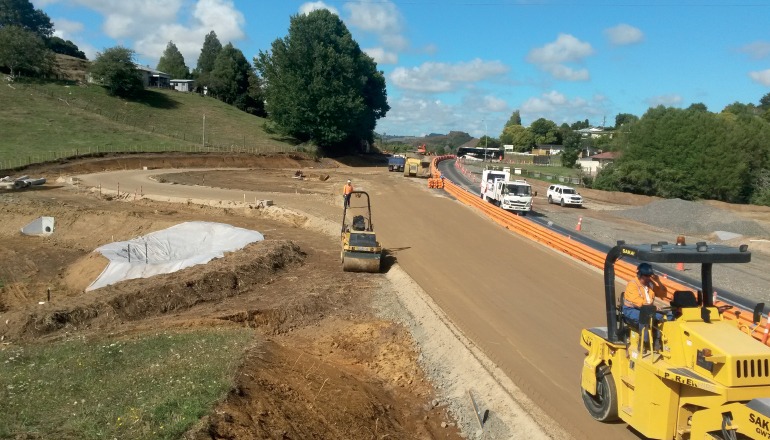Two and a half years after 31-year-old American tourist Kallan Stithem died at a notorious King Country intersection while on his honeymoon, the New Zealand Transport Agency (NZTA) and Higgins have broken earth on a project that should provide a safer road.
Only seven months prior to Stithem’s death, Canadian tourist Michele Smith also died in the same spot – making the black spot a known issue and media target for road safety stories.
The completion date for the three-legged roundabout in Waitomo was originally planned for Christmas last year, but a number of things have held up the build. According to Fairfax Media, property purchase issues have played a chief role in the delays.
For now, however, the project is on track. It is estimated to be complete in May 2015 and has a projected price tag of $3.6 million.
The roundabout will replace a T-intersection where State Highway 3 (SH3) meets State Highway 37 (SH37) – the gateway to the world-famous Waitomo Caves.
NZTA estimates 1300 vehicles a day use SH37 to and from the Waitomo Caves.
Higgins project manager Leon Scheepers says his company has been involved in many similar projects around New Zealand and is well-equipped to handle projects of this type.
A similar Higgins build was the SH2/25 roundabout, which saw it teaming up with Cambridge Construction to improve the road user experience between Auckland and the Coromandel.
“We go through a number of stages on projects like this,” Scheepers explains.
“[These include] traffic management set up, survey work, clearing the site, bulk earthworks, the installation of stormwater and subsoil drainage, construction of a retaining wall and pavement layers, kerbing and sealing, installation of traffic signs and completion of line marking, landscaping and grassing.”
Scheepers says Higgins has 27 staff involved, but that the traffic management and tight 16-week project time are admittedly a bit of a challenging aspect of the contract.

“All traffic is to be maintained on sealed surfaces during the construction phase. An added challenge is substantial level differences between the old and new road lanes being constructed, as well as the challenge of ensuring traffic can pass through the construction site safely 24 hours per day,” he says.
“[In addition to this] the 16-week project requires the team to work on five different project fronts simultaneously… [This will] achieve completion in this 16-week period, whilst maintaining safe traffic flow through the project and an enjoyable journey for road users.”
To deal with the traffic aspects of the job, Higgins took on Transfield Services as subcontractors.
Other subcontractors include Crawford Construction to do the bulk earthworks; McIndoe Plumbing for the stormwater and subsoil draining work; Evergreen landscaping for fencing and landscaping; Inframax for aggregate supplies; Rural Contractors for sand supplies; and NZBarriers for the retaining walls.
According to Scheepers, a particularly innovative approach to the build is Higgins’ use of HiLab construction in the pavement layers, which is being used to improve the strength of the pavement.
A temporary speed reduction of 70kph has been in place since September 2012 and, while there have been some complaints, most Waitomo residents have been tolerant of the reduced speed limits.
This may be in part because of the impressive machinery Higgins has on site, which includes a fleet of vehicles including two graders, seven diggers, five rollers, two water carts and four trucks.
The New Zealand Transport Agency’s (NZTA) principal safety engineer Michelle Te Wharau says the tender was only announced after undertaking extensive research on previous crashes at the site.
“We worked closely with the Waitomo District Council, police, other road safety partners and the community to identify the best way to improve the intersection,” she says.
The roundabout option was selected after public consultation and feedback and an investigation by NZTA traffic safety experts, all of which also added to the slower timeframes.
“The new roundabout is being built about 100 metres north of the current intersection,” Te Wharau says.
“As part of the project, SH37 will be realigned to improve its link to the new SH3 intersection and a right-turn bay will be built on SH3 for Mangarino Road.
“A roundabout is a more forgiving intersection if people make mistakes… roundabouts provide safety benefits as they encourage slower speeds on their approach and the impact from a crash is less likely to result in death or serious injury.”
The reduced speed limits will remain in place until the project is completed this month.


Parting words from Jeremy Sole- a final column